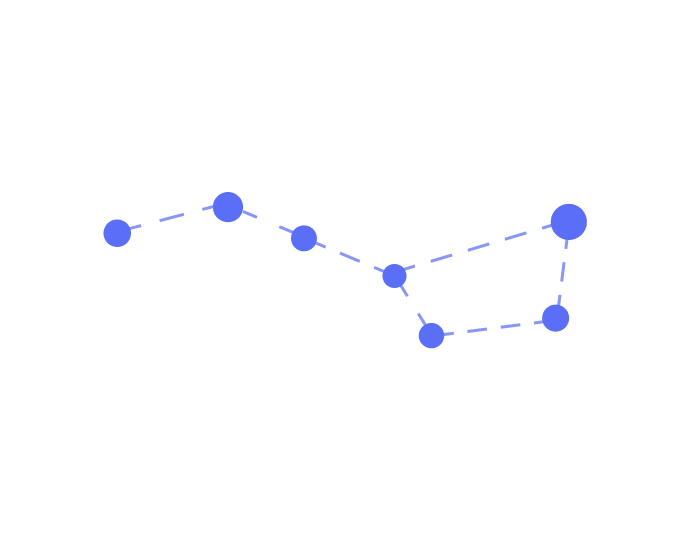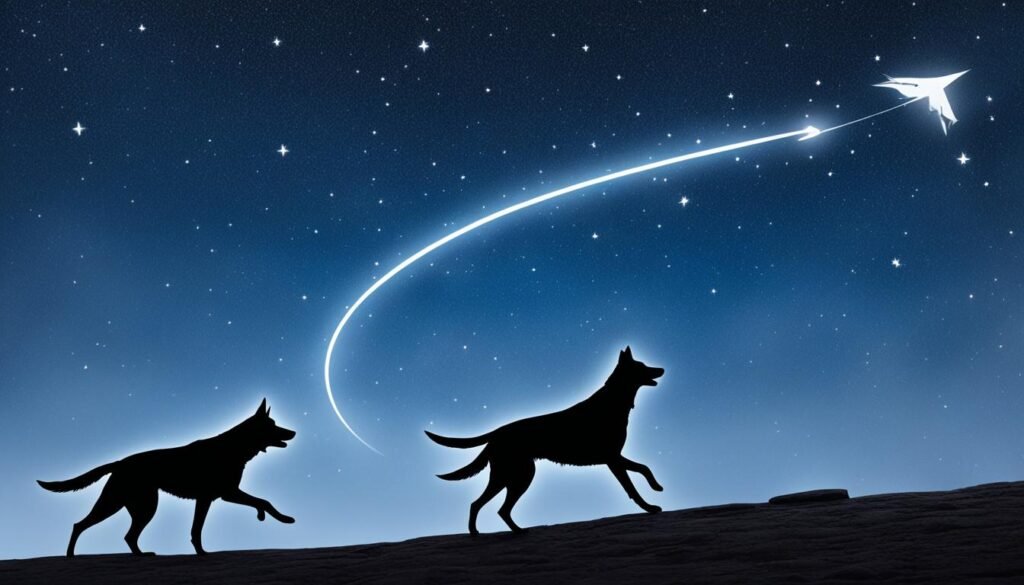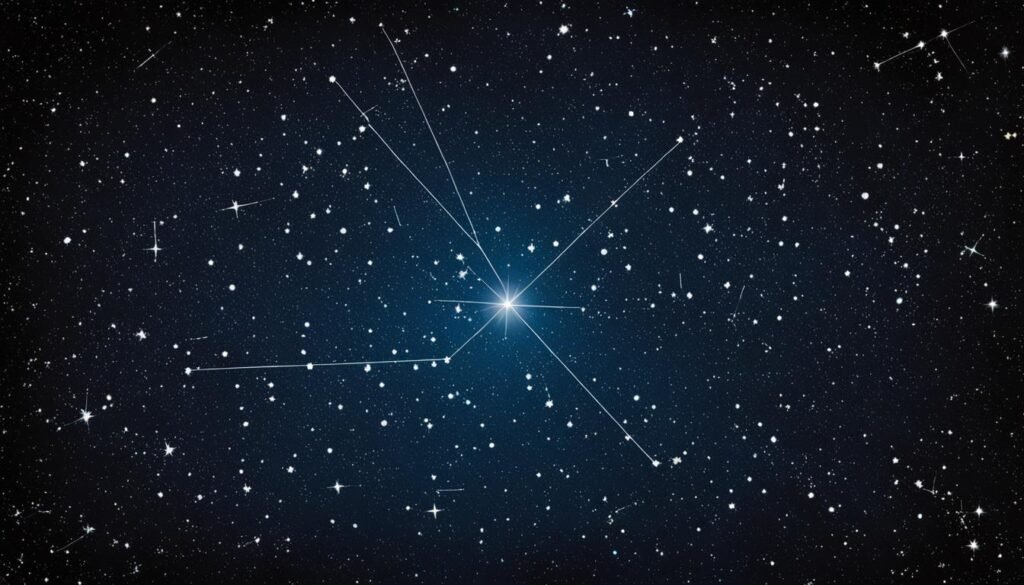
| Genitive | Canis Minoris |
| Abbreviation | CMi |
| Pronunciation | (ˌkeɪnɪs ˈmaɪnər) |
| Main Stars | 2 |
| Brightest Star | Procyon (α CMi) (0.34m) |
| Right Ascension | 7 hours to 8 hours |
| Declination | 13 deg to 0 deg |
| Sq. Deg. Area | 183 |
| Crosses Meridian | 9PM, Mar |
| Visible Lat. Range | +90, -75 deg (°) |
| Best Viewing Season | Winter (Northern Hemisphere) |
Discover the celestial marvels as you unlock the secrets of the Canis Minor constellation. This succinct guide is crafted to illuminate the lesser-known facts about this constellation, famously dubbed the Lesser Dog. Although minute in size, the Canis Minor constellation shines with historical and astronomical significance. You’ll traverse time, learning about the constellation’s place in ancient Greek mythology while focusing your telescopes on its stellar wonders.
From its brightest star Procyon to the constellation’s rich lore, this guide serves as your personal celestial chart. As you read on, you will come to appreciate this constellation’s vibrancy and why it has captivated the eyes and imaginations of stargazers throughout the millennia. With essential Canis Minor constellation facts at your fingertips, prepare to peer deeper into the cosmos than ever before.
Key Takeaways
- Understand why Canis Minor, though smaller, holds significant celestial prestige.
- Learn about Procyon and its companions, key luminaries that embellish the Lesser Dog.
- Uncover the tenacious myths that sew the constellation’s place in ancient cultures.
- Master the art of locating the constellation from various vantage points on Earth.
- Trace the impact of Canis Minor on the evolution of star mapping and navigation.
- Explore the simplicity and esthetic beauty of the Canis Minor star pattern.
- Prepare for the best seasonal viewing experiences and astronomical events within Canis Minor.
Exploring the Stars of Canis Minor
As you embark on your celestial journey through the Canis Minor star constellation, you’ll encounter stellar phenomena that are both close to our solar system and fascinatingly unique. Among these, certain stars stand out due to their brightness, composition, and place in the cosmos. Let’s dive deeper to understand what makes these stars so captivating.
Procyon (Alpha Canis Minoris) – The Little Dog Star
Procyon, also referred to as Alpha Canis Minoris, is the crowning glory of the Canis Minor star pattern. This celestial gem is a mere 11.41 light-years from Earth, making it the eighth-brightest star in our night sky. Procyon is a part of a binary star system; the main star, Procyon A, shares its space with the faint white dwarf, Procyon B. This proximity to Earth affords you a brilliant view, cementing Procyon’s status as a cosmic landmark.
Gomeisa (Beta Canis Minoris) – A Gamma Cassiopeiae Variable
Gomeisa sparkles in the constellation’s tapestry as Beta Canis Minoris. This star’s fast rotation and Gamma Cassiopeiae variable nature manifest in fluctuating luminosity—the hallmark of a star draped in a shroud of matter. Sitting approximately 170 light-years away, Gomeisa’s subtle changes in brightness are still discernible, a testament to its resilient luminance in the vast expanse of space.
Luyten’s Star (GJ 273) – One of Earth’s Nearest Neighbors
One cannot overlook Luyten’s Star when discussing the Canis Minor star constellation. Known as GJ 273, this red dwarf is among Earth’s closest stellar neighbors, being just 12.36 light-years away. Despite its proximity, its dim glow challenges even the determined amateur astronomer, though it holds an important place among the nearby stars within our galactic neighborhood.
| Star Name | Designation | Distance from Earth (light-years) | Apparent Magnitude | Type |
|---|---|---|---|---|
| Procyon | Alpha Canis Minoris | 11.41 | 0.34 | Main-sequence Star, Binary System |
| Gomeisa | Beta Canis Minoris | 170 | 2.89 | Gamma Cassiopeiae Variable |
| Luyten’s Star | GJ 273 | 12.36 | 9.84 | Red Dwarf |
These stars are just the beginning of what Canis Minor has to offer. As you gaze upon the constellation, let the luminosity of Procyon guide your eyes, the variable light of Gomeisa add intrigue to your observations, and the faint twinkle of Luyten’s Star remind you of the ever-present, yet often hidden gems in our sky.
The Lore and Mythology Surrounding Constellation Canis Minor
When you gaze up at the constellation Canis Minor, you are not just looking at a collection of stars, but a rich tapestry of stories that stretch across history and culture. Known for its simplicity and brilliance in the night sky, this constellation’s stories have fascinated humans for millennia. In ancient Greek mythology, Canis Minor’s stars are often associated with one of the dogs following the great hunter Orion—a narrative steeped in companionship and loyalty.
Ancient Greek Origins: The Lesser Dog in Orion’s Hunt
Delve into the tales of Greek mythology and you’ll encounter Canis Minor as an integral part of Orion’s hunting pack. While not as prominently recognized as its counterpart, Canis Major, the **Canis Minor constellation mythology** weaves a compelling narrative about Maera, the trusted dog of Icarius. Icarius, the unfortunate wine maker who was murdered by shepherds, was avenged by Maera, whose grief was so profound that Zeus placed them among the stars as a testament to faithfulness and sacrifice.
Cultural Significance: From Mesopotamia to Polynesia
The influence of the **Canis Minor constellation history** extends well beyond Greek stories, finding its place in the cultural astronomy of civilizations across the world. In ancient Mesopotamia, the constellation was often depicted as a rooster, showing the diversity in celestial interpretation. Similarly, in the sprawling narratives of the Aztecs and Polynesians, the brightness of Canis Minor was incorporated into their night sky mythos, painting a diverse and universal connection to the stars.
| Culture | Symbology | Narrative Influence |
|---|---|---|
| Greek | Canine Companion | Orion’s Hunt, Loyalty, and Sacrifice |
| Mesopotamian | Rooster | Dawn and New Beginnings |
| Aztec & Polynesian | Guiding Brightness | Navigation and Creation |
The stories encircling the **constellation Canis Minor** serve not only as a means for understanding the skies but also as a way to glimpse into the collective human psyche across eras and geographies. With every look at the constellation, consider the innumerable eyes that have gazed upon it before you, each drawing a different inspiration from its luminescent form.

Navigating Canis Minor in the Night Sky
The constellation of Canis Minor may be small in size, but it is remarkably significant and easy to locate, offering skywatchers clear waypoints during their celestial explorations. For those looking to capture its essence, understanding the Canis Minor constellation location and implementing key viewing tips can greatly enhance the stargazing experience. Beyond the simple information, there are also breathtaking Canis Minor constellation images available to inspire and guide you.
Finding the Constellation Canis Minor from Various Latitudes
Whether you are in the Northern or Southern Hemisphere, Canis Minor is visible for you at certain times of the year. Positioned in the second quadrant of the northern sky, this constellation can be detected from latitudes +90° to -75°. For avid stargazers in the northern latitudes, look upwards during the late winter months and for southern observers, it’s best to gaze northwards after sunset. Procyon, the brightest star in Canis Minor, makes for an excellent starting point due to its luminosity and distinct coloration.
Canis Minor’s Role in the Winter Triangle and Winter Hexagon
Canis Minor plays a crucial role in two major asterisms—the Winter Triangle and the larger Winter Hexagon. As you observe the sky, locate Procyon to help you identify these patterns, the lesser-known but equally enchanting cousins of the famous Summer Triangle. Alongside Orion and other constellations like Taurus and Gemini, Canis Minor contributes to a larger sky mosaic. Using Procyon as a guide, viewers can trace the geometric figures of these asterisms, adding a layer of excitement to winter’s nocturnal canvas.
Here are a few viewing tips to add to your astronomical repertoire:
- Scan the skies during late winter for the best view of Canis Minor.
- Use a star app or star chart to differentiate between Procyon in Canis Minor and other bright stars nearby.
- Find an observation spot away from city lights to enhance the visibility of the constellation.
- Photographing the constellation? Use a long exposure on your camera to capture the most detail.
Embarking on the quest for Canis Minor can lead to a rewarding journey through the stars. Whether observing with the naked eye, wielding a lens, or searching for celestial stories, this constellation offers clarity and direction in the expansive night sky.
Constellation Canis Minor’s Place in Astronomy History
The proud legacy of the Canis Minor constellation endures in astronomical history, deeply anchored in the foundations established by ancient scholars. It’s a celestial narrative that stretches from the scrolls of antiquity to the navigational charts of seafaring societies. As you chart your course through the constellations, remember the Canis Minor constellation star names and the invaluable Canis Minor constellation map that has guided explorers through time and space.
Ptolemy’s Almagest and the Legacy of Constellation Mapping
A pivotal moment in celestial cartography was the documentation of Canis Minor by the legendary astronomer Claudius Ptolemaeus in his Almagest. This work didn’t merely list stars within Canis Minor; it enshrined them into the annals of astrological and astronomical studies, positioning this constellation as a key reference for observers around the globe.
Influence on Naval and Polynesian Navigation
For millennia, Canis Minor has not only captivated the gaze of astronomers but also guided the voyages of mariners. Medieval Arabian academics illuminated the nights with their insights into these stars, and the Polynesians, masters of the vast Pacific, utilized these brilliant celestial markers for direction, integrating them into their expansive tradition of wayfinding.

The Distinctive Canis Minor Constellation Star Pattern
As you explore the heavens, the Canis Minor constellation, with its distinct star pattern, is a fascinating celestial sight. This constellation may not boast numerous stars, but its simplicity aids observers in identifying it swiftly in the night sky. Central to recognising this constellation is the main duo of stars: Procyon and Gomeisa. These stars form a pattern that is not only easily distinguishable but also play a pivotal role alongside constellations such as Orion and Monoceros in accentuating the astronomical narrative woven across our galaxy.
Observing the Canis Minor star pattern offers not just an opportunity to see one of the sky’s asterisms but also to connect with a history that spans back to ancient civilizations. Below, you’ll find a table outlining the key features of Procyon and Gomeisa that make up this unique celestial formation.
| Star Name | Apparent Magnitude | Distance from Earth (light-years) | Stellar Classification |
|---|---|---|---|
| Procyon (Alpha Canis Minoris) | 0.34 | 11.46 | F5 IV-V |
| Gomeisa (Beta Canis Minoris) | 2.89 | 170 | B8 Ve |
These stars each tell their own story, contributing to the tapestry above. While Procyon, a yellow-white star, may outshine its partner in terms of brightness and proximity, Gomeisa speaks to the heart of astronomy as a shimmering blue-white star that aids in defining this constellation’s intriguing pattern.
Whether you’re a seasoned astronomer or a curious night-sky observer, understanding the Canis Minor star pattern will enhance your appreciation for the grandeur of our universe. Keep an eye out for Canis Minor constellation images that capture the splendor of this duo against the cosmic backdrop—proof of the beauty that the lesser celebrated patterns hold within our celestial sphere.
Essentials of Observing the Constellation Canis Minor
As the nights unfold in the months of February and March, the tapestry of the night sky reveals the opportunity to behold the constellation Canis Minor in all its celestial splendor. With its position prominent against the backdrop of the cosmos, the lesser known Lesser Dog offers stargazing aficionados a unique glance at ancient myth and modern astronomy.
Best Seasonal Viewing Tips for the Lesser Dog
For the avid sky watcher, pinpointing the Canis Minor constellation location becomes an event to anticipate yearly. Guided by the radiant beacon of Procyon, your gaze shall find solace in the arms of this small constellation nestled near the larger, more illustrious bodies of the night sky. Patience combined with the right vantage point—where the southern skies are clear and dark—intensifies the chances of catching sight of this cosmic companion. Experts frequently suggest armoring yourself with Canis Minor constellation images for a smoother identification process.
Observing Highlights: Deep Sky Objects and Meteor Showers in Canis Minor
Moving beyond the brilliance of Procyon lies the allure of fainter deep sky curiosities, such as galaxy NGC 2485, ready to be discovered by those equipped with the correct observational tools. Moreover, your stargazing experience may coincide with the Canis-Minorids meteor shower, where nature’s very own celestial show plays out in the theater of the universe. Arm yourself with time-honored techniques and the latest Canis Minor constellation viewing tips to capture the astronomical wonders of the Lesser Dog.
FAQ
What is the history behind the Canis Minor constellation?
The Canis Minor constellation’s history dates back to ancient times, notably chronicled in Ptolemy’s Almagest where it was listed as one of the original 48 constellations. It is traditionally associated with the Lesser Dog in Greek mythology, often depicted as one of Orion’s hunting dogs.
What are the main stars in the Canis Minor constellation?
The principal stars of Canis Minor include Procyon (Alpha Canis Minoris), the Little Dog Star, and Gomeisa (Beta Canis Minoris), a Gamma Cassiopeiae variable star. Another notable star is Luyten’s Star (GJ 273), which is one of the sun’s closest neighbors.
What is Procyon, and why is it significant?
Procyon, also known as Alpha Canis Minoris, is the brightest star in the Canis Minor constellation and the eighth-brightest star in the night sky. It plays a significant role in celestial navigation due to its brightness and is part of a binary star system with a white dwarf companion named Procyon B.
Can Canis Minor be easily spotted in the night sky?
Yes, Canis Minor can be relatively easily spotted due to the brightness of Procyon. It’s best seen in the northern hemisphere during the months of February and March, where it’s visible in conjunction with the Winter Triangle and the Winter Hexagon asterisms.
Does Canis Minor have any deep sky objects worth observing?
While Canis Minor is not known for a plethora of deep sky objects due to its small size, it does contain some galaxies like NGC 2485. The constellation is also home to the lesser-known Canis-Minorids meteor shower, an event that provides a spectacle under good conditions.
What mythology is associated with Canis Minor?
Canis Minor is enriched with mythology, most notably from the Greeks who associated it with the Lesser Dog, a companion to the hunter Orion. Additionally, it’s linked to the story of Icarius and his dog Maera. The constellation’s stars have also been significant in various other cultures around the world including Mesopotamian, Aztec, and Polynesian civilizations.
What role does Canis Minor play in celestial navigation?
Historically, Canis Minor has played a role in celestial navigation due to Procyon’s brightness and position. It is a part of the Winter Triangle and Winter Hexagon, which have served as guides for sailors and travelers, and were used for navigation by Polynesians as well as in medieval Arabian astronomy.
What is the Canis Minor constellation star pattern?
The star pattern of Canis Minor is simple and distinctive, primarily consisting of its two bright stars, Procyon and Gomeisa. This pattern forms a small yet recognizable asterism that has played an important role in the broader constellation configuration alongside Orion and Monoceros.
Where is Canis Minor located in the night sky?
Canis Minor is located in the second quadrant of the northern hemisphere and can be observed from latitudes ranging from +90° to -75°. It can be a guide for locating nearby constellations such as Orion and is a part of larger asterisms like the Winter Triangle and Winter Hexagon.
What is Luyten’s Star, and how can it be observed?
Luyten’s Star, also known as GJ 273, is a faint red dwarf and one of the closest stars to Earth, sitting approximately 12.36 light-years away. Due to its faintness, it presents a challenge for amateur observers but is an intriguing target for those with the proper equipment and viewing conditions.






